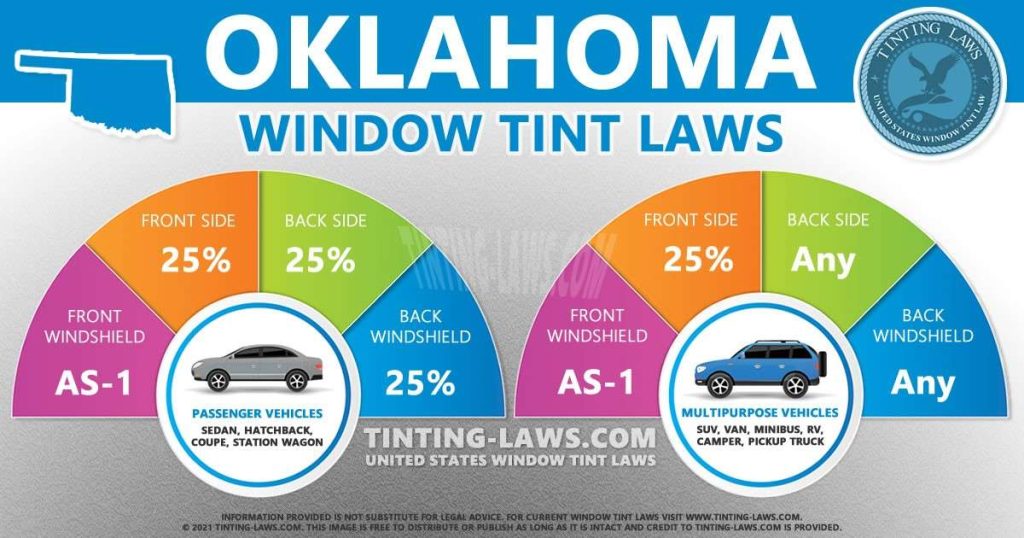Oklahoma Window Tinting Laws
| Oklahoma Window Tint Law: | ||
|---|---|---|
| Sedan | MPV | |
| Windshield | AS-1 | AS-1 |
| Front Side | 25% | 25% |
| Back side | 25% | Any |
| Rear window | 25% | Any |
Oklahoma window tint laws restrict windshield tint above AS-1 line.
Front side windows may have up to 25% light transmission. Back side windows and rear window may have 25% VLT on passenger vehicles, and any darkness on MPV.
Car window tinting laws in Oklahoma were enacted in 2005.
We have provided all the necessary information about your car’s window tint, including how dark or reflective the tint is allowed in your state.
There are also additional car window tinting rules and regulations in Oklahoma so make sure you read all about it below.
Window tint darkness in Oklahoma
The percent of visible light allowed through your car windows is called VLT: Visible Light Transmission.
The percentage of light allowed through your film and glass in Oklahoma is very specific and different for sedan cars and SUV cars or vans.
Tint darkness for sedans:
- Windshield: Non-reflective tint is allowed above the manufacturer’s AS-1 line or top 5 inches.
- Front Side windows: Must allow more than 25% of light in.
- Back Side windows: Must allow more than 25% of light in.
- Rear Window: Must allow more than 25% of light in.
Tint darkness for SUV and vans:
- Windshield: Non-reflective tint is allowed above the manufacturer’s AS-1 line or top 5 inches.
- Front Side windows: Must allow more than 25% of light in.
- Back Side windows: Any darkness can be used.
- Rear Window: Any darkness can be used.
Window tint reflection in Oklahoma
Window tint can reflect incoming light and reduce glare and heat.
Oklahoma window tint law permits a certain window reflection when using a tint so make sure you pay attention to this as well.
Tint reflection for sedans:
- Front Side windows: Must not be more than 25% reflective.
- Back Side windows: Must not be more than 25% reflective.
Tint reflection for SUV and vans:
- Front Side windows: Must not be more than 25% reflective.
- Back Side windows: Must not be more than 25% reflective.
Other Oklahoma window tint rules and regulations:
Oklahoma does have several other important laws, rules and regulations pertaining to window tinting. They include the following:
- Side Mirrors: Dual side mirrors are required if back window is tinted.
- Restricted Colors: No color-altering materials are permitted.
- Certificates: Film manufacturers need to certify the film they sell in the state. Check with your dealer if they are using certified film.
- Stickers: No sticker to identify legal tinting is required.
- Medical Exceptions: Oklahoma allows medical exemptions for special tint.
- Penalties: Misdemeanor, penalties in Section 17-101 of Olahoma statutes.
Keep in mind that Oklahoma tinting laws and regulations may be interpreted differently in your county or place of residence.
We always recommend double-checking our information with your local DMV or law enforcement authorities.

Our information about window tint laws in Oklahoma was last updated in 2024.
Tinting laws in Oklahoma were enacted in 2005.
In case any of our info provided is not up to date or correct be sure to contact us so we can fix it. Thanks!
Trusted industry leader in providing accurate window tint laws. Share with confidence:
State of Oklahoma Info
Oklahoma is a state located in West South Central United States.
Oklahoma is the 20th most extensive and the 28th most populous of the 50 United States.

A major producer of natural gas, oil, and agriculture, Oklahoma relies on an economic base of aviation, energy, telecommunications, and biotechnology.
It has one of the fastest growing economies in the nation, ranking among the top states in per capita income growth and gross domestic product growth.
Oklahoma City and Tulsa serve as Oklahoma’s primary economic anchors, with nearly two thirds of Oklahomans living within their metropolitan statistical areas.
Capital: Oklahoma City
Population: 3,986,639
Area: 69,898 sq mi (181,195 km2)
Cities in Oklahoma: Oklahoma City, Tulsa, Norman, Edmond, Broken Arrow, Stillwater, Lawton, Moore, Fort Sill, Muskogee, Enid, Bartlesville, Owasso, Tahlequah, Ardmore, Midwest City, Claremore, Altus, Anadarko, Ada, El Reno, Guthrie, Shawnee, Picher, Hollister, Yukon, McAlester, Ponca City, Durant, Weatherford, Chickasha, Sentinel, Cushing, Toppers, Elk City, Broken Bow, Okay, Tishomingo, Miami, Jenks, Duncan, Del City, Sapulpa, Pawhuska, McLoud, Sand Springs, Boise City, Pryor Creek, Valliant, Woodward
Counties in Oklahoma: Adair, Alfalfa, Atoka, Beaver, Beckham, Blaine, Bryan, Caddo, Canadian, Carter, Cherokee, Choctaw, Cimarron, Cleveland, Coal, Comanche, Cotton, Craig, Creek, Custer, Day, Delaware, Dewey, Ellis, Garfield, Garvin, Grady, Grant, Greer, Harmon, Harper, Haskell, Hughes, Jackson, Jefferson, Johnston, Kay, Kingfisher, Kiowa, Latimer, LeFlore, Lincoln, Logan, Love, Major, Marshall, Mayes, McClain, McCurtain, McIntosh, Murray, Muskogee, Noble, Nowata, Okfuskee, Oklahoma, Okmulgee, Osage, Ottawa, Pawnee, Payne, Pittsburg, Pontotoc, Pottawatomie, Pushmataha, Roger Mills, Rogers, Seminole, Sequoyah, State Level Sites, Stephens, Texas, Tillman, Tulsa, Wagoner, Washington, Washita, Woods, Woodward